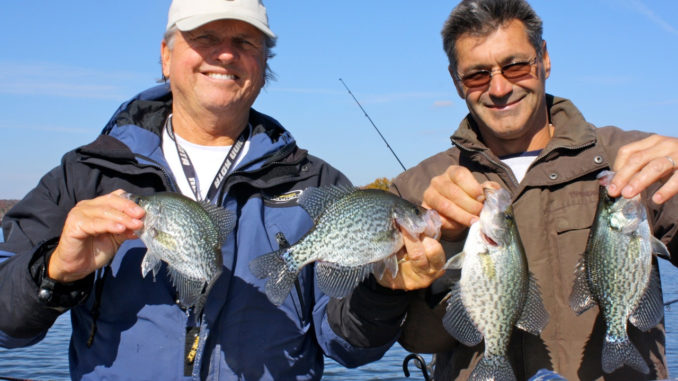
Slow-trolling jigs is most-productive method for filling your cooler with Lake Tillery crappie.
March Madness isn’t confined to basketball courts. Another sports-related frenzy takes place this month on Lake Tillery, an inconspicuous 5,260-acre reservoir on the Yadkin/Pee Dee system that forms the border between Montgomery and Stanly counties in North Carolina’s rural, southern Piedmont.
The madness at Tillery isn’t about hoops, but about the crappie fishing that reaches its peak this month, according to crappie sleuths Jim Blair and Robert Patterson, both of whom reside on the shores of the lake.
Blair has been fishing Tillery seriously for crappie since 1985. After Patterson moved to Norwood in 1984, the two became fishing buddies. Patterson grew up fishing farm ponds near Sanford, but upon meeting Blair, he surrendered his bassin’ gear in favor of crappie tackle and quickly assimilated his mentor’s knowledge.
Blair himself learned the ins and outs of crappie fishing from locals who also instructed him on how and where to plant brush piles, how to make his own jigs and how to master the art of slow-trolling for crappie.
“Before local fishermen showed me the ropes, I knew very little about trolling for crappie,” said Blair. “Today, most fishermen troll for crappie, but that wasn’t the case years ago.”
Blair puts those trolling lessons to good use by slow-trolling for crappie in March, employing the technique known as flat-lining, also called long-lining.
The technique involves placing baits at the right depths by using a basic principle: the deeper the fish, the more line that’s let out and the heavier the jig, usually 1/8-ounce; the shallower the fish, the less line that’s let out, and the lighter the jig, usually 1/16-ounce.
“Some of it is trial-and-error, plus past experience, to get the baits to run in the strike zone,” Blair said. “Over time, you learn how much line must be set out with a given-sized jig to reach a particular depth.
“We catch crappie eight or nine months out of the year, but March is the best for size and numbers of fish while trolling,” he said. “We usually catch our limit trolling, with the majority of fish ranging from 11 to 13 inches. Crappie pushing 15 and 16 inches are scarce at Tillery, but occasionally we’ll catch a few.
Blair caught his biggest Lake Tillery crappie – a 3-pound, 6-ounce behemoth – while trolling. Patterson’s biggest weighed a shade under three pounds. They credit the N.C. Wildlife Resources Commission’s 8-inch size minimum and 20-fish daily creel limit for giving Tillery’s population of blacka crappie a boost.
“I haven’t caught a white crappie at Tillery in more than 15 years,” Blair said.
Commission samplings at Tillery confirm the scarcity of white crappie.
“Although white crappies are common in Tuckertown and High Rock, they are rare in Lake Tillery, and we haven’t collected one there since 2005,” said biologist Troy Thompson.
Later in the spring, as crappie become cover-oriented, Blair changes tactics.
“When the fish move into brush, I use ultralight spinning tackle to drop small jigs into the brush,” he said. “But in March, I stick to trolling.”
For slow-trolling, Blair rigs his 19-foot skiff with no more than eight rods, six in rod holders across the stern mounted in rod holders and two other rods set off at the sides of the boat, one on each side.
“I can manage eight rods effectively without getting the lines tangled if I make wide turns and move about slowly,” Blair said. “Should a striper hit instead of a crappie, then I’ll have a mess with the striper running across lines. I can’t stop a big fish with the light gear I use.”
When Blair says “light,” he means it. He spools his Shimano spinning reels with 4-pound Bass Pro Shops Excel monofilament and attaches the reels to 11-foot, light-action Sam Heaton-signature graphite rods. The wispy tackle generates more strikes in the clear water at Tillery.
At the business end, he ties on 1/16- and 1/8-ounce homemade jigs in chartreuse, red or silver and attaches Kalin Triple Threat grub trailers in acid rain, june bug, and lemon meringue. He also likes Charlie Brewer Slider grubs in purple and chartreuse, but he shuns live bait.
Blair sets his boat in motion with his trolling motor, moving at 1 mph.
When the water begins to warm at Tillery toward the end of the month, crappie move to the creek mouths.
For that reason, Blair targets creek mouths sampling depths from 10 to 30 feet by employing different-sized jigheads and letting out various lengths of line. When a strike occurs, he adjusts his rigs so the majority run at the depth that the strike occurred.
“Sometimes, the fish will hit the side rods that are set further out from the boat; at other times, the back rods get the most action,” Blair said. “When the fish are active, the location of the rod doesn’t matter.”
Patterson said many of the strikes are gentle, without much of a telltale bend of the rod.
“Many strikes are so subtle that the rod tip just quivers,” he said. “The fish are still lethargic in March, and the strikes are delicate takes.”
Around the creek mouths, Blair relies upon his instincts and experience and electronics to select an area for trolling.
“I might begin trolling at places where I’ve caught fish before or where I see any bait activity,” he said. “Otherwise, I look for pods of forage with my depth finder. Flat lines of forage on my electronics are not as promising as those pods.”
Blair and Patterson have their favorite creeks for March crappie. Early in the month, they fish Mountain and Woodrun creeks on the lake’s upper end. Other areas worth trying are the mouths of Jacobs Creek, Swift Island Creek, the “steel bridge creek” near Nick’s restaurant, Cedar Creek and Plantation Creek.
Blair describes the perfect day for trolling for March crappie as overcast with a little chop and slightly stained water. Given those conditions, crappie might bite all day long.
Conversely, fishermen should probably stay home on a bright, sunny day with 10 to 20 mph winds.
“It’s not worth the aggravation,” said Blair. “Strong winds and light tackle are not compatible.”
Water level isn’t an issue, since the lake remains stable almost year-round.
Slow-trolling allows fishermen to cover lots of territory, a definite advantage since crappie can be scattered this time of year, with water temperatures ranging from the upper 50s to lower 60s.
Once March passes and the water warms, putting crappie in shallow brush, Blair and Patterson set aside their trolling outfits and drop small jigs into brush using ultralight spinning gear.
Whenever the crappie bite stalls on the lake, they resort to “shooting” small jigs under piers and around pilings.
Although there are no guarantees, the crappie fishing at Tillery in March is about as close to a slam dunk as fishermen can expect.
DESTINATION INFORMATION
HOW TO GET THERE/WHEN TO GO: Lake Tillery is at the southern end of the Yadkin River chain of lakes, forming the border between Stanly and Montgomery counties. The lake is east of Albemarle and Norwood and bounded on the north by Morrow Mountain State Park and the Uwharrie National Forest. It can be reached from NC 24/27/73. with the main access on the east side of the NC 24/27 bridge. Other public landings are at Lower Richland Creek off SR 1110 at the west side off of Lake Shore Dr. Crappie fishing is good year-round except for the dog days of summer. The fishing peaks in March for size and numbers of fish.
TECHNIQUES/TACKLE: Flat-lining, aka long-lining, is best in conjunction with light tackle to offset the clear water at Tillery. Troll the creek mouths in 10 to 30 feet of water, sampling various depths. Later, when the fish move into brush, use ultralight spinning gear to drop crappie jigs and minnows into the brush piles.
GUIDES/FISHING INFO: Maynard Edwards, Yadkin Lakes Guide Service, 336-249-6782; Joe’s Bait & Tackle, Albemarle, 704- 982-8716. Also see Guides & Charters in Classifieds.
ACCOMMODATIONS: Stanly County Chamber of Commerce, Albemarle, 704-982-8116; Morrow Mountain State Park offers camping facilities and family vacation cabins, 704-982-4402.
MAPS: Kingfisher Maps, www.kfmaps.com. Some local tackle shops have the old Gemini map of Lake Tillery.

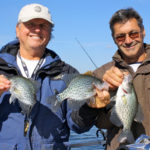
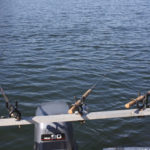
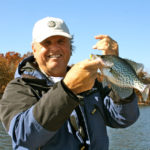
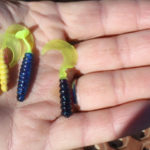
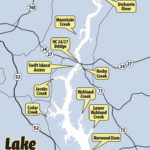



Be the first to comment